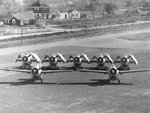It is not the took off that stressed the LG and airframe, but the arrested landing and the aircraft will be heavier yet with an airframe modded for that. Additionally the view over the nose is terrible and it would have been very difficult to land on a carrier.
P-40 have had its' shortcomings, flimsy construction was not one of them.
I've listed the weights of the interesting U/C gears, and P-40 can simply retain the heavy 630-700 lbs ones for CV duties, rather than reduce the strength (and weight at ~550 lbs) as they have done for later marks. Should do as good as Hellcat's 10% heavier U/C.
The view over the nose was maybe not the greatest thing, somewhere between Hurricane and Spitfire (no fuel tank between pilot and engine in P-40).
The P-40 does not have 'water brakes' - down protruding coolers, like P-51, Hurricane or Spitfire. Should be safer plane to ditch in.
The difference in drag at climbing speeds is minimal and offset by the lower wing loading.
The Spitfire I, on normal boost and with CS prop, was at 2800+ fpm range at lower altitudes, vs. 2600+ for the Hurricane I, same conditions, of course same engines.
Yes, and I stand by that statement.
Okay
See the Grumman specs for the F4F-3:
and note the performance for the overload fighter at 7432lb.
and then look at the specs for the F4F-4:
and note the performance at 7426lb and then note the discrepancy between the F4F-4 and F4F-3 at near identical weights! The time to climb to 20K ft has gone from 8.4min in the F4F-3 to 12.7min in the F4F-4 yet the weights are the same! Grumman "sexed up" the performance stats for the F4F-3/4 and then had to back away from them as it was obvious that actual service aircraft, in combat, could not hope to match Grumman's claims, and USN/USMC pilots said so in no uncertain terms.
Grumman 'sexed up' climb rating for the F4F-3. The speed rating was as it was said by Grumman, for both F-3 and F-4.
Because, for a land based aircraft it was probably made little difference to a Merlin III fighter with CS prop, so they left the TO rating at 6.25lbs, especially since pilots knew that they were authorized to use higher TO boost if it became necessary.
Could be.
Perhaps someone with a good book about the Merlin could shed some light on this and other issues?

